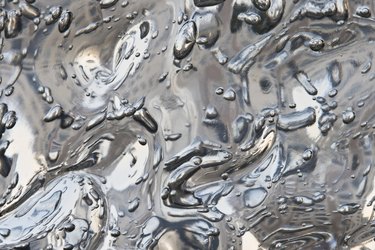
Gel medium is a clear acrylic dispersion substance with the thickness of hair gel. Gel medium comes in a variety of thicknesses and properties, but its basic purpose is to change the consistency or appearance of acrylic paint. Gel medium is available at art supply stores, either brick-and-mortar or online, in the acrylic paint section.
Function
Video of the Day
The primary function of gel medium is to broaden the technical capabilities and results of acrylic paints. Depending upon the type of medium employed, it can alter the consistency of paint, add sheen, reduce gloss, adhere mixed media elements to the surface of the painting, increase film integrity, add a transparent coat, reduce the cost of paint, prime a canvas, repair a painting, protect a painting and bind paint. Artists use gloss medium to highlight specific elements of a painting, such as the breaks of waves or the edges of clouds. Gel medium also works great in collage, decoupage and transfers.
Video of the Day
Types
The basic choices of gel mediums are matte, gloss and semi-gloss, each one providing a different level of sheen on a canvas. Gel mediums are further differentiated by texture and use. Clear tar gel adds sheen and is perfect for dripping and drizzling effects. Self-leveling clear gel adds a high gloss. Soft gel is used for glazing and has excellent transparency. Soft gel gloss is useful as an adhesive in collages. Regular gel extends paint while maintaining its consistency. Heavy gel increases the body of paint and holds peaks. Extra heavy gel is ideal for impasto. High solid gel adds high gloss and dries quickly. The matte finish of high solid gel retains brushstrokes well. Fine pumice gel adds texture and is a good ground for pastels. Coarse pumice gel and extra coarse pumice gel create a granular surface. Glass bead gel contains actual glass beads and gives a painting a luminescent quality. Clear granular gel adds a translucent, textured layer. Fine garnet gel contains a violet-toned almandine garnet, while extra coarse garnet gel has large crystalline pieces that reflect light.
Considerations
While gel medium is versatile and effective in painting, it also brilliant for adhering elements. You can use a paintbrush and apply it as a glue. You can apply it as a layer before and after integrating three-dimensional elements. You can use several layers of gel medium to create a photocopy transfer, if you let it dry overnight before soaking it and then gently rubbing off the paper. Use gel medium to coat collage elements, brushing it on both sides to avoid curling.
Features
The features that differentiate gel mediums are viscosity -- ranging from watery to nearly solid -- as well as leveling differences that affect the texture of the paint. Mediums are also typified by their reflectance, with some maintaining translucency and others adding a wax-like coat.
Texture
Textural quality is another defining factor for gel mediums which, over the years, have integrated sand, sawdust and bits of glass to create their properties. In addition, some gel mediums operate as molding pastes and others have an ultraviolet light filter to help artworks resist fading. One of the most important features of gel medium is that it is archival, so that it will not discolor or lose its adhering properties over time.